Vice-Admiral The Right Honourable Cuthbert Collingwood, 1st Baron Collingwood
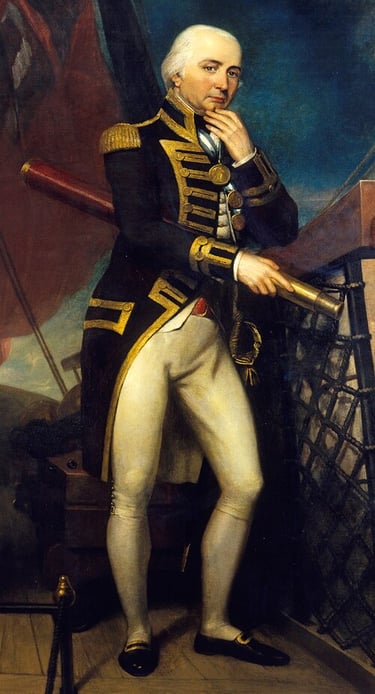

A Comprehensive Biography (1748-1810)
Early Life and Family Background (1748-1761)
Cuthbert Collingwood was born on 26 Sept 1748 in a house on The Side, a street of medieval origin in Newcastle-upon-Tyne. He was the eldest of 3 surviving sons born to Cuthbert Collingwood, a bankrupt merchant & trader, and his wife Milcah Dobson, who came from near Appleby-in-Westmorland. The family had fallen on hard times despite their descent from an established border family. The Collingwoods' misfortunes traced back to Cuthbert's great-grandfather, who was executed by hanging in Liverpool for supporting the House of Stuart during the Jacobite rising of 1715. This resulted in the family being deprived of their ancestral estate at Eslington Park, Northumberland, forcing subsequent generations into trade & commerce.
Of the 11 children born to his parents, only six survived into adulthood, including Cuthbert & his brothers Wilfred (who would also serve as a naval officer) & John. Young Cuthbert received his early education at the Royal Grammar School, Newcastle from 1759, where he studied Latin & received instruction in the classical curriculum. The school was notorious for its harsh discipline, particularly the frequent use of flogging even for younger students, an experience that would profoundly influence Collingwood's later attitudes toward corporal punishment aboard his ships.
Entry into Naval Service (1761-1775)
At the age of twelve, in August 1761, Collingwood's life took a decisive turn when he and his brother Wilfred entered naval service as volunteers aboard the frigate HMS Shannon (36 guns) in the Mediterranean. The ship was commanded by their maternal uncle, Captain Richard Braithwaite (sometimes spelled Brathwaite), who took personal charge of his nephew's nautical education. Under Braithwaite's tutelage, young Collingwood received comprehensive instruction in the essential arts of seamanship: sailing, mathematics (including trigonometry), navigation (including celestial navigation), and the use of the sextant. He served with his uncle until the Peace of 1763 ended the Seven Years' War.
Collingwood's apprenticeship continued under Braithwaite's command aboard HMS Gibraltar (24 guns) from early 1766 through March 1767, and subsequently on HMS Liverpool (32 guns) from autumn 1767 until spring 1772. Both vessels were based on the Newfoundland station, with the Liverpool later serving in the Mediterranean, providing the young officer with extensive experience in diverse waters and conditions.
In 1766, at age eighteen, Collingwood was officially rated as midshipman. By 1767, he had transferred to HMS Liverpool, where he served for several years in the Mediterranean fleet, eventually advancing to the position of Master's Mate—a role responsible for navigation—while preparing for his lieutenancy examinations.
In March 1772, Collingwood joined the guard-ship HMS Lenox (74 guns) at Portsmouth, commanded by a distant relative, Captain Robert Roddam. The following year, in 1773, he was sent to Sheerness in Kent with a party of eighteen seamen before joining HMS Portland (50 guns) under Captain Andrew Barkley. The Portland sailed for Jamaica via Madeira, patrolling waters around the Leeward Islands, Windward Islands, and Jamaica. On 1 June 1773, Collingwood transferred to HMS Princess Amelia (80 guns), which sailed to Florida and Newfoundland before returning to England in August 1773, where she paid off in September.
American Revolutionary War (1774-1783)
Early Service and Battle of Bunker Hill
As tensions escalated in the American colonies, Collingwood sailed to Boston in February 1774 aboard HMS Preston (50 guns) under the command of Captain John Robinson, carrying the flag of Vice-Admiral Samuel Graves. He remained stationed in Boston Harbour for approximately eighteen months as revolutionary forces encircled the town.
On 17 June 1775, Collingwood participated in one of the war's most significant early engagements: the Battle of Bunker Hill. He commanded the boats that landed the second wave of troops under General William Howe, 5th Viscount Howe, fighting with the naval brigade ashore. His conduct in this fierce battle earned him his lieutenant's commission that very day—a field promotion that demonstrated his courage and capability under fire.
To have his promotion officially confirmed by the Admiralty, Collingwood needed to return to England. He transferred to HMS Somerset (70 guns) as fourth lieutenant under Captain Edward le Cras, sailing via Nova Scotia and arriving home in January 1776. His rank of lieutenant was officially confirmed in spring 1776.
West Indies Service and Court Martial
In April 1776, Collingwood joined the 14-gun sloop HMS Hornet as first lieutenant, serving in the Leeward Islands. The ship was commanded by the tyrannical Commander Robert Haswell, whom Collingwood considered a "rotten officer" lacking the courage to engage enemy shipping. Their relationship deteriorated rapidly, and on 30 September 1777, Collingwood was court-martialled aboard HMS Winchelsea (32 guns) in Port Royal, Jamaica, charged with "disobedience and neglect of duty." Although acquitted of all charges, he was censured for petulance and received the recommendation that he should "endeavour to be more cheerful in future."
Friendship with Nelson and First Commands
Shortly after his court-martial in 1777, Collingwood met Lieutenant Horatio Nelson when both served on the frigate HMS Lowestoffe (28 guns) under Captain William Locker. In July 1778, Collingwood succeeded his new friend as second lieutenant on the Lowestoffe. This marked the beginning of a profound friendship that would endure until Nelson's death at Trafalgar. After a period aboard HMS Bristol (50 guns), flagship of Vice-Admiral Sir Peter Parker, Collingwood received his first independent command.
On 20 June 1779, Collingwood was promoted to commander of the brig HMS Badger, again succeeding Nelson. On 22 March 1780, he was posted captain of the frigate HMS Hinchinbrook (28 guns)—once more following in Nelson's footsteps. These early promotions for both officers were largely due to the patronage of Vice-Admiral Parker, who recognised exceptional talent when he saw it.
Within weeks of his promotion, Collingwood assumed command of the disastrous San Juan expedition after Nelson fell ill. The venture, which attempted to cross Central America from the Atlantic to the Pacific by navigating the San Juan River and Nicaraguan lakes, proved catastrophic. Collingwood lost one hundred and eighty of his two hundred men to disease, bringing the survivors back to Jamaica.
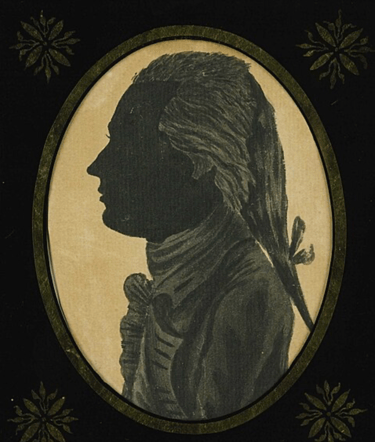

Shipwreck and Survival
In December 1780, Collingwood transferred to HMS Pelican (24 guns). On 22 July 1781, the Pelican captured the French vessel Le Cerf (16 guns), but triumph turned to disaster on 2 August when a devastating hurricane struck while the ship navigated off the uninhabited Morant Keys, Jamaica. The Pelican foundered and was destroyed.
Collingwood demonstrated exceptional leadership during this crisis, organizing his crew's evacuation onto rafts constructed from broken rigging and planks. The malnourished survivors endured ten days in this hostile, barren environment before Collingwood managed to dispatch a boat to Jamaica. The frigate HMS Diamond (32 guns), commanded by Captain Christopher Parker, eventually rescued the crew. At the subsequent court-martial—mandatory for any captain who loses his ship—Collingwood was fully exonerated, the court recognising that the tremendous extent of the hurricane had caused widespread devastation throughout the region.
Collingwood remained without a ship on half-pay in the East Indies before returning to England in early 1782. After a brief period in London, he was appointed to command HMS Sampson (64 guns) from January until April 1783, serving in home waters as the American Revolutionary War drew to a close.
Silhouette of Collingwood drawn by Horatio Nelson when both were serving in the West Indies
Post-War Service and the Navigation Acts (1783-1792)
West Indies Command
Following the peace, Collingwood continued in employment, going out to the Leeward Islands in September 1783 in command of HMS Mediator (44 guns), giving Commissioner John Moutray passage to Antigua. The ship was stationed at English Bay and then Barbados, where Collingwood renewed his close friendship with Captain Nelson.
In 1784, both officers were ashore together in Antigua for several weeks, where they became attracted to the unobtainable Mary Moutray, the American-born wife of the Royal Commissioner. During frequent evenings in her company, Collingwood and Nelson sketched each other's portraits—Collingwood kept Nelson's drawing of him for the rest of his life, a treasured memento of their friendship.
Enforcement of the Navigation Laws
From 1784 through 1786, Collingwood served with Nelson and his brother, Commander Wilfred Collingwood, enforcing the Navigation Acts in the West Indies. Their mission was to prevent American ships from trading illegally with British colonies. Collingwood and Nelson shared extreme views on the interpretation of these laws, placing them in opposition to their commander-in-chief, Rear-Admiral Sir Richard Hughes. During this period, they seized several American merchantmen as prizes, actions that led to Nelson facing a civil trial in May 1785. Collingwood fully supported his friend throughout these controversial proceedings.
Shore Leave and Personal Life
In July 1786, Collingwood arrived back in England and paid off the Mediator a month later. For the next four years, he lived with relatives in Northumberland, rejecting the offer of HMS Ardent (64 guns) and remaining unemployed—a not uncommon situation for officers during peacetime when the navy contracted dramatically.
During the Spanish Armament of 1790, Collingwood assumed command of the newly commissioned HMS Mermaid, which he took to the West Indies under Rear-Admiral Samuel Cornish before paying her off in May 1791. Shortly before sailing, Collingwood began correspondence with Sarah Blackett, daughter of John Erasmus Blackett, a merchant and mayor of Newcastle, whom he had met through his friend and superior, Admiral Roddam.
On 18 June 1791, at Newcastle Cathedral—some fifty yards from where he was born—Collingwood married Sarah. Her dowry of £6,250 enabled the couple to rent (and later purchase) a house on Oldgate Street in Morpeth. In May 1792, they welcomed their first daughter, Sarah. Their second daughter, Mary Patience, would be born in summer 1793, after Collingwood had returned to sea. As Collingwood would have no male heir, his eventual barony would become extinct upon his death.
French Revolutionary Wars (1793-1802)
Channel Fleet Service
In February 1793, following the outbreak of hostilities with France, Collingwood was given command of the dull-sailing HMS Prince at Plymouth, serving in the Channel as flag-captain to Rear-Admiral Sir George Bowyer. The ship participated in fruitless cruises from July to August and October to December.
The Glorious First of June (1794)
In 1794, having left the Prince in January, Collingwood served in the same capacity to Bowyer aboard HMS Barfleur at the Battle of the Glorious First of June. During this fierce engagement on 1 June 1794, Collingwood caught Admiral Bowyer in his arms when the admiral's leg was shot away by enemy fire. The Barfleur suffered casualties of nine men killed and twenty-five wounded.
Despite the ship's significant involvement and casualties, it was deemed that the Barfleur had fought from too far to windward. Collingwood was controversially among many officers not awarded a gold medal, much to his fury. This perceived injustice would rankle with him for years. Following Bowyer's retirement, Collingwood moved to HMS Hector in August, but being unable to man her adequately, he endured a brief period of half-pay.
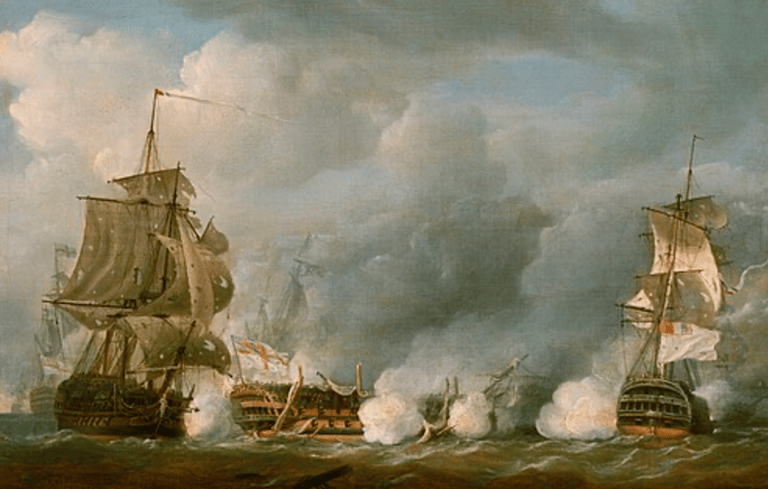

HMS Excellent and Gunnery Excellence
In December 1794, Collingwood was appointed to HMS Excellent, in which ship he was employed in the Mediterranean from July 1795. Through devoted practice and relentless drilling, Collingwood soon brought the Excellent to an advanced state of efficiency in gunnery. He believed that if a ship could release three well-aimed broadsides in five minutes, "no enemy could resist them." This dedication to gunnery excellence would prove decisive in the battles to come.
Battle of Cape St. Vincent (1797)
The Excellent played a major role in the Battle of Cape St. Vincent on 14 February 1797. As the British fleet under Admiral Sir John Jervis engaged the Spanish fleet, Commodore Nelson broke from the line of battle in HMS Captain to block the passage of the Spanish van. Seeing Nelson's bold maneuver, Collingwood, commanding from the rear of the British line, immediately ordered the Excellent to follow and support his friend.
Collingwood took part in the battle known as the Glorious First of June.
On Admiral Jervis's orders, the Excellent went to Nelson's aid. Collingwood's ship engaged at such close quarters with the massive Spanish vessel Salvador Del Mundo that "a man might jump from one to another." After several rapid and devastatingly accurate broadsides from the Excellent, the Salvador Del Mundo struck her colors, as did the San Isidro. Rather than take possession of these prizes, Collingwood pressed on to attack the other Spanish ships being engaged by the British, the San Josef and San Nicolas. He also engaged the giant Santísima Trinidad, the largest warship in the world—with help from HMS Orion under Captain Sir James Saumarez, though the massive Spanish flagship was eventually escorted away by her compatriots.
During the engagement, a double-headed shot narrowly missed Collingwood's head, striking the base of the mast near where he stood. He took it home as a souvenir for his father-in-law. The Excellent suffered casualties of ten men killed and twelve wounded.
Following the battle, Collingwood refused to accept a gold medal unless he also received the one owed to him for the Glorious First of June. King George III promptly sanctioned its award, having been advised by Captain Sir Robert Calder, the bearer of Jervis's dispatches, that Collingwood's endeavors had even eclipsed Nelson's in the Battle of St. Vincent. With the medal came a letter of apology from the First Lord of the Admiralty, Earl Spencer. In 1798, Collingwood was further rewarded with an appointment as colonel of marines.
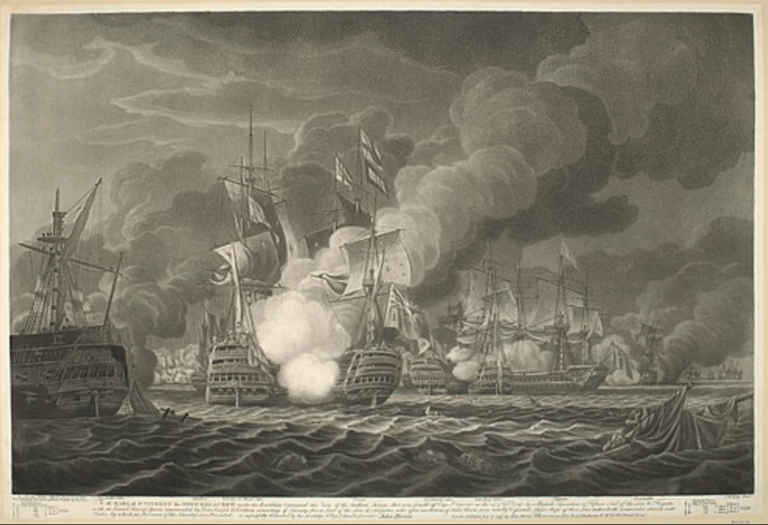

HMS Excellent with other ships during the battle at Cape St Vincent, 1797. Collingwood would serve four years in command of the ship.
Frustration and Blockade Duty
The sometimes testy Collingwood became further irked in 1798 when he was denied the opportunity to join Nelson's detached squadron that won the Battle of the Nile on 1 August. Having continued to serve with the fleet off Cadiz, the Excellent was sent home at the end of 1798 and paid off at Portsmouth in January 1799. Collingwood was immediately offered command of HMS Atlas but declined it in order to spend a period of recuperation ashore with his family in Morpeth.
Promotion to Flag Rank (1799-1803)
Rear-Admiral
On 14 February 1799, Collingwood was promoted to rear-admiral. By May, he was back at sea serving in the Channel Fleet with his flag aboard the very slow HMS Triumph, commanded by Captain Thomas Seccombe, whom Collingwood considered fairly useless. He was detached under Rear-Admiral Sir Charles Cotton as part of a reinforcement of twelve sail of the line to the Mediterranean during the Brest fleet's cruise from April to August 1799, and was with the force that followed the enemy back to its home port at the end of the campaign.
Remaining on blockade with the Channel Fleet, he transferred in early 1800 to HMS Barfleur, commanded successively by Captain George Hopewell Stephens (until December), Captain John Ommanney (until the Peace of Amiens in 1802), and briefly by Captain John Irwin in spring 1801. After sitting on various courts-martial into the Bantry Bay mutiny, Collingwood struck his flag in May 1802 and went home to his house in Morpeth, which he had purchased a year earlier after previously renting it.
Of his time in Morpeth, he remarked, "Whenever I think how I am to be happy again, my thoughts carry me back to Morpeth." It was during these peaceful interludes that Collingwood indulged his passion for gardening and his famous habit of pressing acorns into the ground during walks across the Northumbrian hills, believing that if everyone did likewise, there would always be a bountiful supply of oak for Britain's fleet. His favorite companion during these walks was his dog, Bounce, who would later accompany him to sea.
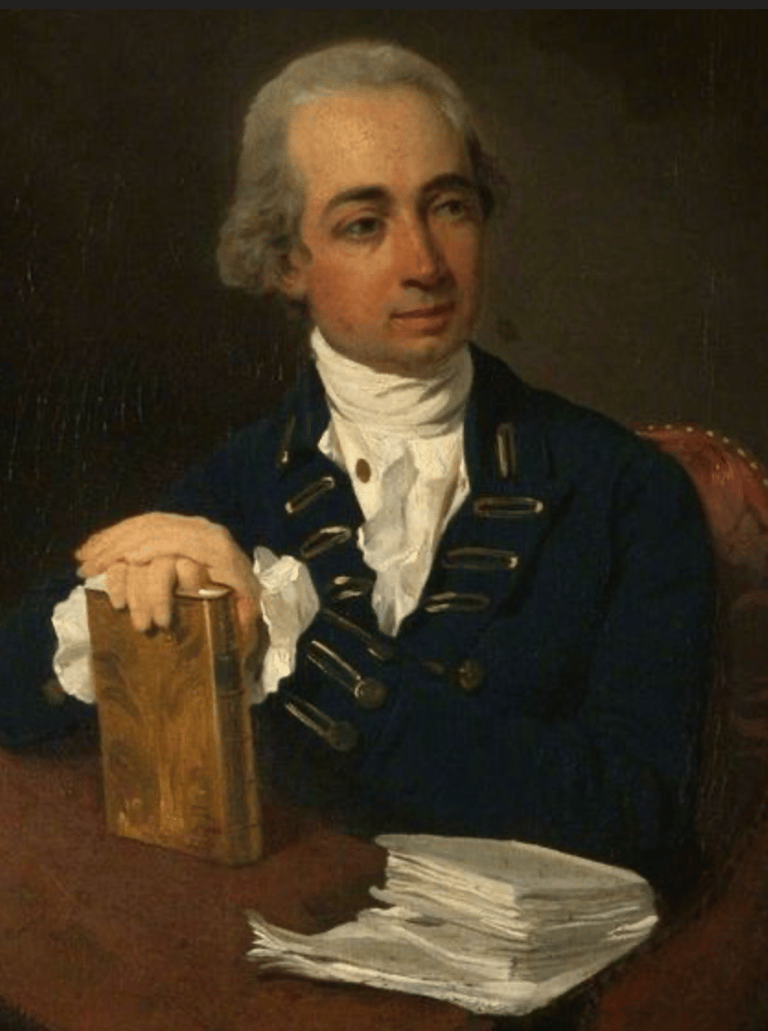

Napoleonic Wars (1803-1805) - Continued
Return to Active Service
When war resumed on 16 May 1803, Collingwood left home for the Admiralty and then a ship, never to return home again. Together with his beloved dog Bounce, he initially served under Admiral the Honourable William Cornwallis off Brest, going out in June aboard HMS Diamond, commanded by Captain Thomas Elphinstone, and assuming command of the inshore squadron. In this post, he flew his flag briefly aboard HMS Colossus under Captain George Martin, again briefly in August aboard HMS Minotaur under Captain Charles Moore Mansfield, and until December aboard the aptly named HMS Venerable under Captain George Reynolds.
In February 1804, he shifted his flag to HMS Culloden, Captain George Reynolds, and took command of the Rochefort squadron. On 23 April 1804, he was promoted to vice-admiral. After a brief spell in HMS Prince under Captain Richard Grindall, he was moved in August to HMS Dreadnought under Captain Edward Rotherham. During April 1805, he arrived off Ferrol as second-in-command to Vice-Admiral Sir Robert Calder.The
Cadiz Squadron and Strategic Brilliance
In May 1805, Collingwood took command of a small squadron of just three or four sail of the line off Cadiz. It was on this station, with his tiny force, that he witnessed the arrival of Vice-Admiral Pierre Villeneuve and the combined Franco-Spanish fleet, which had fought the Battle of Cape Finisterre against Calder's fleet on 22 July.
In a display of remarkable tactical nerve and strategic deception, Collingwood refused to be intimidated when sixteen enemy sail of the line were dispatched to chase him off. Using false signals to disguise the small size of his squadron, he convinced the combined fleet that his ships were part of a much larger British force. The enemy, believing themselves at risk of engagement with superior numbers, declined to engage and returned to harbor. Collingwood then boldly returned and kept watch on the allies in Cadiz—a tactical victory that prevented the combined fleet from breaking out and would prove one of several factors leading to the Battle of Trafalgar.
Collingwood shown in later life in a painting In Paxton House.
Ships from various British squadrons soon began to congregate off Cadiz, and on 28 September 1805, Vice-Admiral Lord Nelson arrived to assume overall command.
Preparation for Trafalgar
In mid-September, at Nelson's order, Collingwood transferred his flag from the Dreadnought to the 100-gun first-rate HMS Royal Sovereign and was appointed second-in-command of the fleet. The Royal Sovereign had just been given a new layer of copper on her hull, making her the fastest of the large ships in the fleet—a fact that would prove significant in the coming battle.
On 9 October, Nelson sent Collingwood his plan of attack—the famous "Nelson Touch"—which was subsequently relayed to the captains throughout the fleet. The plan called for the British fleet to approach in two columns, breaking the enemy line at two points to create a chaotic mêlée that would favor British gunnery and seamanship.
The Battle of Trafalgar (21 October 1805)
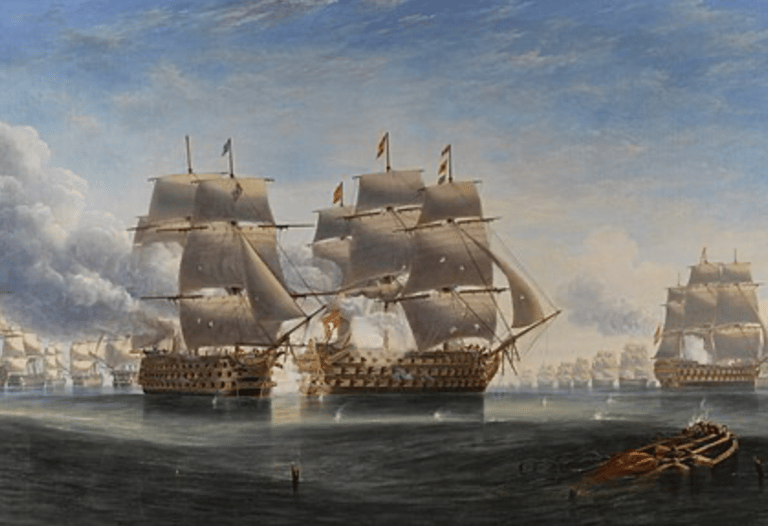

The opening engagement at Trafalgar; Royal Sovereign raking the stern of the Spanish flagship Santa Ana. John Wilson Carmichae
The Approach
On the morning of 20 October, the combined French and Spanish fleet sailed from Cadiz. The Battle of Trafalgar followed immediately on 21 October as Villeneuve drew up his fleet in the form of a crescent. The British fleet bore down in two separate lines: one led by Nelson in HMS Victory, and the other by Collingwood in HMS Royal Sovereign.
As the fleets converged, Nelson hoisted his famous signal: "England expects that every man will do his duty." On seeing it, Collingwood is said to have remarked, "I wish Nelson would make no more signals; we all understand what we have to do." However, he ordered it to be announced to the ship's company, by whom it was received with the greatest enthusiasm.
"See How That Noble Fellow Collingwood Carries His Ship Into Action"
Thanks to her newly coppered hull, the Royal Sovereign raced ahead of the other ships in the lee column, drawing considerably ahead of the rest of the fleet. She was the first British ship engaged and was immediately targeted by six enemy vessels. Nelson, watching from Victory, pointed to the Royal Sovereign as she penetrated the centre of the enemy's line and exclaimed, "See how that noble fellow Collingwood carries his ship into action!"
Probably at the same moment, Collingwood, as if in response to his great commander's observation, remarked to his flag-captain Edward Rotherham, "What would Nelson give to be here?"
The Engagement
Royal Sovereign closed with the Spanish flagship Santa Ana and opened fire with devastating effect. Collingwood's years of relentless gunnery drill now paid spectacular dividends. The Royal Sovereign's broadsides were fired with such rapidity and precision that the Spanish flagship was on the verge of sinking almost before another British ship had fired a gun—a feat that owed everything to Collingwood's belief that three well-aimed broadsides in five minutes could overcome any enemy.
Several other enemy vessels came to Santa Ana's assistance, hemming in the Royal Sovereign on all sides. The British flagship was severely damaged and left unable to maneuver after being dismasted, but she was relieved by the arrival of the rest of the British squadron. Not long afterward, Santa Ana struck her colours.
During the intense action, Collingwood was wounded in the leg by a splinter. However, he had been wearing silk stockings—as he advised other officers to do, which allowed the surgeon to better treat leg wounds. One officer reported that during the height of the battle, Collingwood calmly ate an apple while discussing the progress of the fight. He had been fortunate: he was one of only three officers left alive on the quarterdeck. At one point during the fierce firing, Collingwood paused to ensure that a sail was properly folded—a tale that perfectly illustrates his methodical, disciplined character.
Assuming Command
On learning of Nelson's death, Collingwood assumed command of the fleet and his position as acting Commander-in-Chief. He is said to have shed tears on learning of the death of his great friend. Because of the extensive damage to the Royal Sovereign, Collingwood transferred his flag to the frigate HMS Euryalus, Captain the Honourable Henry Blackwood. He gave orders for the Sovereign to be towed away from the action while she was still afloat, taking the captured Vice-Admiral Villeneuve aboard with him. He later transferred his flag to HMS Queen, Captain Francis Pender.
The Controversial Decision Not to Anchor
Anticipating a storm, Nelson had intended that the fleet should anchor after the battle. However, on taking command, Collingwood chose not to issue such an order, disagreeing with Nelson's earlier directive for several reasons. Many of the British ships and prizes were so damaged that they were unable to anchor, and Collingwood concentrated his efforts on taking only those damaged vessels likely to survive the approaching storm in tow.
Collingwood was subsequently criticized for failing to see to the safety of the prizes in the storm that followed the battle and for disregarding Nelson's orders to anchor. However, in his defense, not a single British ship was lost as a result of either the battle or the storm—a remarkable achievement given the circumstances. In the ensuing gale, many of the prizes were wrecked on the rocky shore and others were destroyed to prevent their recapture, but the fighting strength of the Royal Navy remained intact.
Recognition and Honors
On 22 and 24 October, Collingwood wrote his official dispatches to the Admiralty as two letters, informing Britain of the great victory but also of the tragic loss of Nelson. For his part in the victory, Collingwood received a pension of £2,000 per annum, a sword from the Duke of Clarence, and the thanks of both Houses of Parliament. On 9 November 1805, he was raised to the peerage as Baron Collingwood of Caldburne and Hethpoole in the County of Northumberland. The Patriotic Fund awarded him a £500 commemorative silver vase.
Together with all Trafalgar captains and admirals, he received a Naval Gold Medal—his third, after those for the Glorious First of June and Cape St. Vincent. Only Nelson and Sir Edward Berry share the distinction of earning three gold medals for service during the wars against France.
However, Collingwood was disappointed that the barony was enacted to pass only along the male line. He wrote numerous times to the government asking that it be amended so his daughters could inherit the title, but this request was never granted—a source of ongoing frustration for a man who had given so much to his country.
Commander-in-Chief, Mediterranean Fleet (1806-1810)
Appointment and Early Command
After the Battle of Trafalgar, Collingwood was concerned with getting the more heavily damaged ships away for repairs while maintaining the blockade off Cadiz and other ports. In spring 1806, he was formally appointed Commander-in-Chief of the Mediterranean Fleet and elevated to vice-admiral of the red. He flew his flag in HMS Queen, Captain Richard Thomas, and from the end of 1806 in HMS Ocean with Thomas, who would remain as his flag-captain until his death. As his second-in-command, he requested Rear-Admiral John Child Purvis.
Throughout 1806, Collingwood remained off Cadiz, where he fostered a remarkably good relationship with the governor and people through his consideration for the Spanish wounded, whom he had allowed to go ashore following the Battle of Trafalgar. The trust and confidence he inspired in the Spanish would bear significant fruit when they overthrew French domination a couple of years later. During a visit to Cadiz in September 1808, he was so lauded for his assistance and previous kindness to the wounded that a cavalry escort was required to allow his progress to an official dinner—an extraordinary honor for a former enemy commander.
In 1806, while at sea, Collingwood organized the sale of his house at Morpeth after fully inheriting an estate called Chirton from his wealthy third cousin, Edward Collingwood. The Chirton estate, held in trust, included the estate house, a coal mine, cottages, and other buildings. However, Collingwood would never spend any significant time at the property, as he remained continuously on post in the Mediterranean.
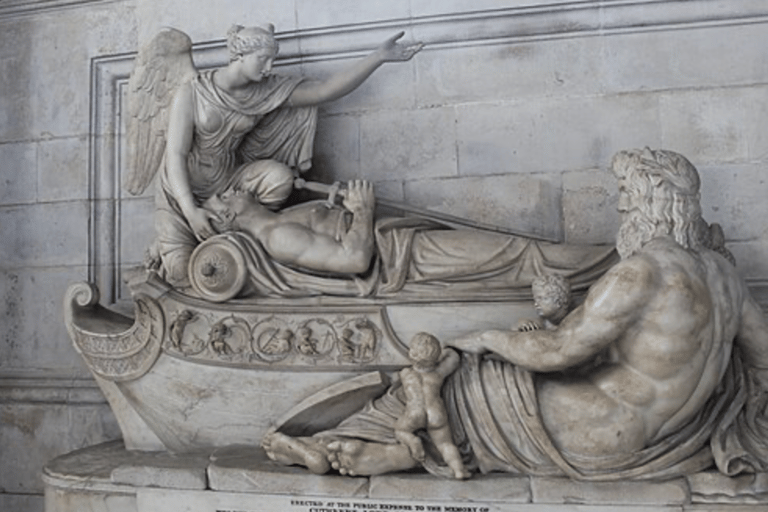

Memorial to Collingwood, St. Paul’s Cathedral, by Richard Westcamott
The Burdens of Command
From Trafalgar until his death, no great naval action was fought in the Mediterranean as a result of the British blockade and Collingwood's careful maneuvering of ships to prevent an enemy fleet from forming. His time as Commander-in-Chief involved maintaining the blockade of French and Spanish ships around the coasts of the Mediterranean, including preventing French squadrons from sailing from the ports of Toulon and Cartagena. Although several small French squadrons attempted to run the blockade—and one successfully landed troops in the Caribbean two months after Trafalgar—the majority were either intercepted or forced to return to port by superior British firepower.
Collingwood's influence in the Navy was significant at this time, with his role as head of some 30,000 men in ships and ports across the Mediterranean. On several occasions, he wrote dispatches and letters to the Admiralty and government urging for more ships to maintain effective blockades. He was occupied in important political and diplomatic transactions, in which he displayed considerable tact and judgment, making visits and carrying out diplomatic discussions with Morocco, Naples, and the Ottoman Empire.
The Burdens of Command
From Trafalgar until his death, no great naval action was fought in the Mediterranean as a result of the British blockade and Collingwood's careful maneuvering of ships to prevent an enemy fleet from forming. His time as Commander-in-Chief involved maintaining the blockade of French and Spanish ships around the coasts of the Mediterranean, including preventing French squadrons from sailing from the ports of Toulon and Cartagena. Although several small French squadrons attempted to run the blockade—and one successfully landed troops in the Caribbean two months after Trafalgar—the majority were either intercepted or forced to return to port by superior British firepower.
Collingwood's influence in the Navy was significant at this time, with his role as head of some 30,000 men in ships and ports across the Mediterranean. On several occasions, he wrote dispatches and letters to the Admiralty and government urging for more ships to maintain effective blockades. He was occupied in important political and diplomatic transactions, in which he displayed considerable tact and judgment, making visits and carrying out diplomatic discussions with Morocco, Naples, and the Ottoman Empire.
Controversial Episodes
In 2006, Collingwood censured Vice-Admiral Sir John Duckworth for abandoning Cadiz to pursue Rear-Admiral Leissègues to the West Indies, even though that controversial officer fought and won the Battle of San Domingo on 6 February 1806. Against his better wishes, Collingwood was then ordered to send the same officer into the Dardanelles with less than clear instructions to act against the Turks in February 1807, although Duckworth's own inadequacies contributed overwhelmingly to the failure of that expedition.
In June 1807, Collingwood took the Mediterranean fleet to the Dardanelles from Cadiz in a more placatory attempt to win the friendship of the Turks, but this proved no more successful than Duckworth's efforts. The squadron had some minor engagements with the Turkish forces but eventually withdrew to prevent ships being damaged by bombardment from shore batteries. Collingwood later visited the Dardanelles himself in August 1807 to negotiate with the Pasha and Sultan under a flag of truce. As a result of his diplomatic efforts, the Ottoman Empire agreed to remain neutral in the Mediterranean—a significant strategic achievement.
Subsequent to the Treaty of Tilsit between Napoleon and the Russian Tsar in July 1807, Collingwood escorted Vice-Admiral Dmitry Nikolayevich Seniavin's Russian fleet out of the Mediterranean to prevent their union with the French. Thereafter, he generally cruised in the vicinity of Sicily to prevent any French attempt on the island, wintering with his ship at Syracuse in late 1807 and early 1808.
The Ganteaume Incident
On 7 February 1808, Collingwood's fleet was absent when Vice-Admiral Honoré Joseph Antoine Ganteaume escaped from Toulon with ten sail of the line and briefly occupied Corfu. Having inexplicably sailed away from a vessel that had come to warn him of Ganteaume's escape, it was not until 3 March that Collingwood heard the news while at Cape St. Vito on the northwest coast of Sicily. He was not overzealous in going in search of Ganteaume, and the French were back at Toulon by 10 April.
There is little doubt that Nelson would have been more active in his pursuit of the French, and the incident did much to illustrate the general consensus that, for all his devotion to duty, Collingwood lacked the tactical appreciation and aggressive instinct required of a fleet commander. He was a superb captain and gunnery expert, dashing in individual ship actions, but as a fleet commander he preferred the life behind his desk to the detriment of his country's dominance over the enemy. Without Nelson, his reputation as a fighter would barely have survived the war.
Support for the Peninsular War
In 1808, Collingwood learned that the Spanish were now Britain's allies following Napoleon's attempted subjugation of their throne, and he was soon furnishing them with supplies and support. In 1808 and beyond, Collingwood sent ships to support British forces and Spanish partisans during the Peninsular War, including preventing the supply by sea of French forces in Spain.
In March 1808, French forces attempted to break out and sail to Italy but were prevented by the assembly of a fleet under Collingwood's command. It was also during this period that Collingwood first wrote of his worsening health, complaining of poor bowels and the lack of exercise after having spent several years continuously at sea.
Final Year of Command
In April 1809, with HMS Ocean in need of repairs following a severe winter, Collingwood removed his flag to HMS Ville de Paris, Captain Richard Thomas. Remaining on watch off Toulon for most of the year, he missed an escape and subsequent return of five French sail of the line during May, but he had the satisfaction of learning that two enemy sail of the line were burned on shore after they had attempted to flee from Rear-Admiral George Martin's squadron on 25 October. Such was his contempt for the French at this time of the war that he suggested one of his subordinates, Rear-Admiral Sir William Sidney Smith, caused him more trouble than the enemy.
In late 1808 and early 1809, while his ship was stationed at Malta, Collingwood was given the additional honorary appointment of Major-General of Marines on 9 January 1809, following the death of Admiral Lord Gardner. The appointment included a stipend of some £1,400 but carried no duties.
Collingwood stationed himself off Port Mahon and Menorca, organising the continuing blockade of French ports, before joining the blockade of Toulon in the summer of 1809. The blockade intercepted a convoy, capturing some 13 ships and destroying two line ships in a minor action—the last offensive action of his career.
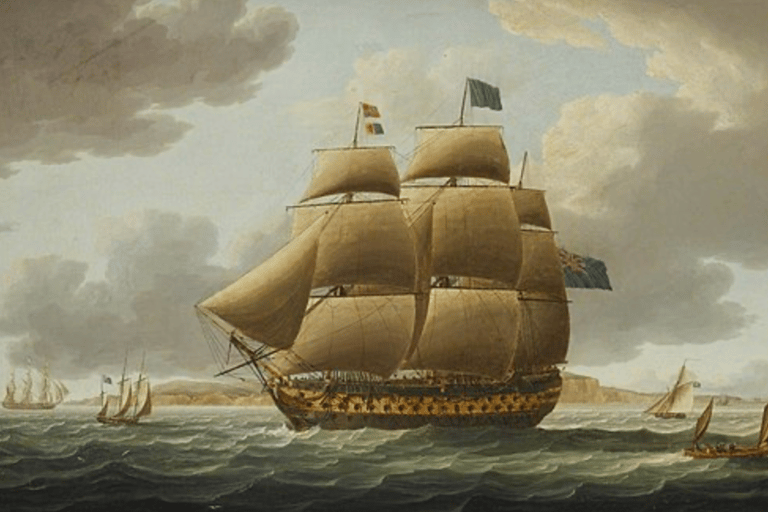

HMS Ville de Paris, the last ship Collingwood sailed on, seen here in a painting by Thomas Buttersworth.
Declining Health and Death (1809-1810) - Continued
The Final Request
The government urgently required an admiral with the experience and skill of Collingwood to remain in command, on the grounds that the country could not dispense with his services in the face of the still potent threat that the French and their allies could pose. However, by February 1810, Collingwood was forced to request the Admiralty to allow him to return home, which was finally granted in February 1810.
On 3 March 1810, Collingwood was ordered home on medical advice, and he finally resigned the station to Vice-Admiral John Child Purvis, who was commanding off Cadiz, with command temporarily passing to Rear-Admiral George Martin before officially transferring to Sir Charles Cotton.
Death at Sea
Hardly able to stand unaided, Collingwood set sail with his flag in HMS Ville de Paris from Port Mahon at 2 p.m. on 7 March 1810. Within four hours of departure, Vice-Admiral Cuthbert Collingwood, 1st Baron Collingwood, died at sea, aged sixty-one. The cause of death was cancer, though he had also suffered from what was likely severe gastrointestinal illness exacerbated by years of unrelenting duty and sedentary life aboard ship.
Collingwood had once written to his wife that he would rather his body be added to Britain's sea defenses than given the pomp of a ceremonial burial. However, his country had other plans for one of its greatest naval heroes.
Return to England and State Funeral
His body was returned to England aboard HMS Nereus (36 guns), Captain Peter Heywood, under the care of his flag-lieutenant George Browne. The Ville de Paris also returned his body to England, where it was then taken by barge up the River Thames to London. His body lay in state for several days at Greenwich Hospital, where thousands came to pay their respects. The genuine grief of the common seamen at his funeral was there for all to see—a testament to the love and respect he had earned from the men who served under him.
On 22 March 1810, Cuthbert Collingwood was buried in the crypt of St. Paul's Cathedral, laid to rest beside his great friend Lord Nelson. The two companions who had served together from their first acquaintance in early life until Nelson's death at Trafalgar were now reunited in death, both entombed in the nation's greatest church.
Estate and Family
On his death, Collingwood's estate was valued at £160,000—a considerable sum for the period and especially remarkable for a naval officer from a less than affluent background who had spent most of his life on modest pay. This wealth had been bolstered by his inheritance of the Chirton estate and coal mine near South Shields in April 1806, as well as prize money accumulated throughout his career, particularly during his time as Commander-in-Chief of the Mediterranean Fleet.
His will left £40,000 each to both his daughters, Sarah and Mary Patience, as specific legacies. As Collingwood died without male issue, his barony became extinct at his death—the very outcome he had repeatedly petitioned the government to prevent by allowing the title to pass to his daughters, as had been allowed to Lord Barham. This failure to secure his daughters' inheritance of his honors remained a source of bitterness to the end.
His widow, Sarah Blackett Collingwood, whom he had married on 16 June 1791, survived him. Despite Collingwood's careful financial management and prudent investment habits, Sarah was known for her excesses in spending, and for one of his standing, Collingwood had remained relatively poor for much of his life. Only during his time in command of the Mediterranean station did he accumulate significant wealth.
His brother Wilfred, also a very promising naval officer who had served with him in the West Indies, had died of tuberculosis in 1787. His other brother John survived him.
Character and Personality
Physical Appearance
Collingwood was 5 feet 10 inches tall, slim, and slightly bent and rheumatic in his later years, with penetrating blue eyes set in a round, pallid face. Being long-sighted, he wore spectacles to read. He did not drink alcohol nor eat to excess, maintaining an abstemious lifestyle that reflected his puritan values.
Temperament and Leadership Style
Collingwood was regarded as politically insightful, benevolent, conscientious, capable, shrewd, and unquestionably brave, whilst also being scholarly, painstaking, methodical, pedantic, puritan, dour, firm, and thoughtful. He had a reputation for being stern and strict yet just, with a tendency to treat his officers more harshly than the common seamen—a reversal of the usual naval practice.
Admiral the Honourable Sir George Elliot suggested that he was unpopular, "an old bear—selfish," and he was renowned for giving less than satisfactory dinners, earning him the nickname "Salt Junk and Sixpenny," not least because of his predilection for offering old meat and cheap wine. Vice-Admiral Sir Thomas Fremantle thought him "severe and reserved," although privately he could be "witty and sardonic."
Out of earshot, midshipmen laughed at him in awe and affection, calling him "Old Cuddy"—though whether these were the same boys who had their pigtails sawn off with a penknife by Collingwood for failing to make correct observations is doubtful. Somewhat at variance to his own piety, he loved to hear about a good scandal and was happy to talk derogatively about colleagues and friends.
The Seaman's Friend
Somewhat solemn and prematurely old, wooden, solitary, formal, conservative, reactionary, and sensitive, he was a pious grandfatherly figure within the fleet. Some suggested he would have made a good bishop. Others affirmed that there was never a better friend to a seaman, and sailor Robert Hay, who served under him, wrote: "He and his dog Bounce were known to every member of the crew. How attentive he was to the health and comfort and happiness of his crew! A man who could not be happy under him, could have been happy nowhere; a look of displeasure from him was as bad as a dozen at the gangway from another man... a better seaman, a better friend to seamen—a more zealous defender of the country's rights and honour, never trod the quarterdeck."
Being reserved and a poor communicator, Collingwood was incapable of relaxing with his men or his officers, although when commanding HMS Excellent he did enjoy the reputation of having an excellent band. Later in his career, he gave up ordering capital punishment—he was opposed to both impressment and flogging—and maintained the strictest of discipline by watering offenders' grog, giving them extra ignominious duties, or occasionally delivering moral lectures accompanied by a stern look of displeasure, both of which were as harsh as a flogging. The men appeared to love him nevertheless, and he was affectionately called "father" by the common sailors.
Professional Capabilities
In independent command of individual ships, Collingwood was dashing in battle with a gusto for hard blows, suggesting that he was happier in command of ships than a fleet. His broadsides were lethal and he was a renowned gunnery expert. It is a fact that Rear-Admiral Sir Edward Berry and he were the only officers to earn three gold medals for actions fought during the wars.
A good administrator but a poor tactician, duty meant everything to Collingwood. His failure to fully inspire his subordinates was illustrated prior to the Battle of Trafalgar, when the captains of the fleet off Cadiz compared his unimaginative puritanical regime most unfavorably to Nelson's inspiring leadership. Nevertheless, the government and later the people of Spain had absolute confidence in his stewardship of the Mediterranean station, and he was trusted implicitly by the demanding Admiral Earl of St. Vincent.
Personal Interests and Relationships
Collingwood's hobby was gardening on his estate at Morpeth in Northumberland. He was famous for his practice of pressing acorns into the ground during his walks across the Northumbrian hills, advocating that if everyone did likewise, there would always be a bountiful supply of oak for Britain's fleet. Some of the oaks he planted are probably still growing more than two centuries later, a living memorial to his foresight and dedication to the Royal Navy.
His favorite companion was his dog, Bounce, who was allowed to sleep next to his cot and was happy enough at sea, although he hated gunfire. The loss of Bounce in 1809 was a significant emotional blow during Collingwood's final, difficult year.
Collingwood was a great friend of Nelson, who could have been his alter-ego—where Nelson was flamboyant and inspiring, Collingwood was methodical and dutiful. He was less enamored of Admiral Sir Roger Curtis and displayed some bitterness toward Admiral Lord Howe as a result of the failure to award him a gold medal following the Battle of the Glorious First of June. Similarly, the failure of the government to allow his honors to descend upon his daughters, as had been allowed to Lord Barham, rankled with him throughout his final years.
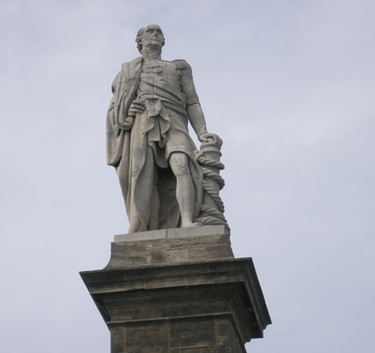

The Collingwood Monument in Tynemouth.
Contemporary Assessment
Collingwood's merits as a naval officer were in many respects of the first order. His political judgment was remarkable, and he was consulted on questions of general policy, regulation, and even trade. The writer William Makepeace Thackeray held that there was no better example of a virtuous Christian Knight than Collingwood, writing:
"Another true knight of those days was Cuthbert Collingwood; and I think, since heaven made gentlemen, there is no record of a better one than that. Of brighter deeds, I grant you, we may read performed by others; but where of a nobler, kinder, more beautiful life of duty, of a gentler, truer heart? Beyond dazzle of success and blaze of genius, I fancy shining a hundred and a hundred times higher, the sublime purity of Collingwood's gentle glory. His heroism stirs British hearts when we recall it. His love, and goodness, and piety make one thrill with happy emotion."
Memorials and Commemorations
Collingwood has been memorialised extensively throughout Britain and the former British Empire. A large monument, the Collingwood Monument, stands in his honor overlooking the River Tyne at Tynemouth. His Grade II listed statue was sculpted by John Graham Lough and stands atop a pedestal designed by John Dobson. The four cannon on the walls flanking the steps at its base came from his flagship, HMS Royal Sovereign. There is also a carved memorial to him at Newcastle Cathedral.
The Maritime Warfare School of the Royal Navy is commissioned as HMS Collingwood, home to training for warfare, weapon engineering, and communications disciplines. The town of Collingwood, Ontario, on Georgian Bay in Canada; the suburb of Collingwood in the Australian city of Melbourne; the town of Collingwood, New Zealand; and the Collingwood Channel (an entrance of Howe Sound near Vancouver, British Columbia) are all named in his honour.
One of the four houses at Collingwood's old school, the Royal Grammar School, Newcastle, is named after him. One of the five houses of British public school Churcher's College is named after him, as is one of the eleven houses at The Royal Hospital School. One of the three secondary schools within Excelsior Academy in Newcastle was named after Collingwood in 2013.
A battalion of the Royal Naval Division (1914-1919) was named after Collingwood. It took part in the Antwerp Campaign (October 1914) and at Gallipoli, receiving so many casualties at the 3rd Battle of Krithia on 4 June 1915 that it never reformed. From 1978 until 1992, British Rail locomotive 50005 was named Collingwood. In November 2005, English, Welsh & Scottish Railway named locomotive 90020 Collingwood at Newcastle station.
Collingwood's former temporary residence in Es Castell close to Mahon, Menorca, is now a hotel and home to a collection of heirlooms relating to his time on the island. The Collingwood Society is a members' society dedicated to his memory.
March 2010 saw the 200th anniversary of Collingwood's death, and a number of major events were organised by "Collingwood 2010" on Tyneside, in Morpeth, and on the island of Menorca.

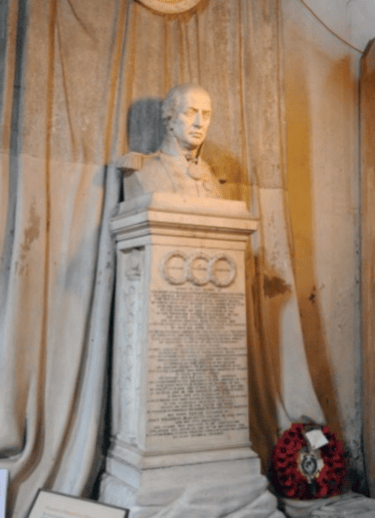
The Collingwood Monument in Newcastle Cathedral.
Connection to Morpeth
Collingwood lived at Collingwood House on Oldgate Street in Morpeth from 1791 until his death in 1810, though he spent precious little time there after 1803. The house represents Point of Interest #13 on Morpeth's Extended Heritage Trail. He is remembered as one of Britain's greatest naval commanders, instrumental in defeating the French fleet, and a hero of the Napoleonic Wars who took command after Nelson's death at Trafalgar.
Historical Significance
Vice-Admiral Cuthbert Collingwood, 1st Baron Collingwood, stands as one of the most dedicated and dutiful officers in the history of the Royal Navy. While he may have lacked Nelson's genius for inspiration and tactical brilliance, his methodical approach, exceptional gunnery skills, personal courage, and unwavering sense of duty made him an indispensable partner to Nelson and a capable, if conservative, fleet commander.
His greatest contribution was perhaps not in any single battle, but in the years of unrelenting blockade duty that kept the French and Spanish fleets bottled up in port, preventing Napoleon from achieving naval supremacy. From 1803 until his death in 1810, Collingwood spent virtually all his time at sea, sacrificing his health, his family life, and ultimately his life itself in service to his country.
The fact that he died at sea, still on duty, having been granted permission to return home only days before, is perhaps the most fitting epitaph for a man who embodied the Royal Navy's highest ideals of service and sacrifice. As Thackeray wrote, beyond the "dazzle of success and blaze of genius" shone "the sublime purity of Collingwood's gentle glory"—a glory earned not through spectacular victories alone, but through a lifetime of quiet, steadfast devotion to duty, honor, and country.
Cuthbert Collingwood remains an exemplar of the virtues that made Britain's Royal Navy the dominant maritime force of its age: professional excellence, personal courage, humane leadership, and above all, an unshakeable commitment to duty that endured until his final breath.

